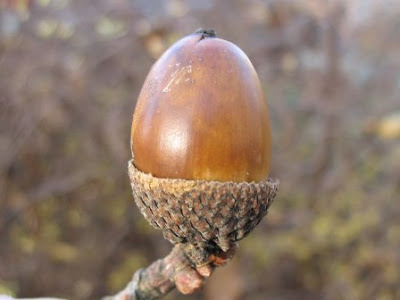 The Sessile Oak (species: Quercus petraea) also goes by the common names Welsh Oak or Durmast Oak. The name "sessile" comes from the fact that the acorn is attached directly to the branch without a stem. The common name "Welsh Oak" is used in Wales where it is the national tree. I´m not sure where the "Durmast" name comes from other than that it can refer to several oak species and might be a reference to the dark colored acorn.
The Sessile Oak (species: Quercus petraea) also goes by the common names Welsh Oak or Durmast Oak. The name "sessile" comes from the fact that the acorn is attached directly to the branch without a stem. The common name "Welsh Oak" is used in Wales where it is the national tree. I´m not sure where the "Durmast" name comes from other than that it can refer to several oak species and might be a reference to the dark colored acorn. The leaves of the Sessile Oak are about 5-7 inches long with lobes that are not too deeply indented and that tapper back towards the stem which is less than one inch long. As you can see in the image above they turn yellow and then brown. I saw one tree that had a reddish tone to it.
The leaves of the Sessile Oak are about 5-7 inches long with lobes that are not too deeply indented and that tapper back towards the stem which is less than one inch long. As you can see in the image above they turn yellow and then brown. I saw one tree that had a reddish tone to it. The images in this post where taken near Basel, Switzerland where this tree species is quite common. When grown out in the open this tree can form a roundish shape but in the forrest where it has to compete for light it tends to grow quite tall and has a long, straight trunk (image below). This characteristic makes it a valuable timber wood that is both tough and somewhat elastic. Historically is was used for ship building and for wine barrels.
The images in this post where taken near Basel, Switzerland where this tree species is quite common. When grown out in the open this tree can form a roundish shape but in the forrest where it has to compete for light it tends to grow quite tall and has a long, straight trunk (image below). This characteristic makes it a valuable timber wood that is both tough and somewhat elastic. Historically is was used for ship building and for wine barrels. This tree is similar to the Pedunculate Oak (Quercus Robur). One differnce between the two is that the acorn on the Pedunculate Oak is not "Sessile" and has a short stem.
This tree is similar to the Pedunculate Oak (Quercus Robur). One differnce between the two is that the acorn on the Pedunculate Oak is not "Sessile" and has a short stem. Image above is of the reverse side of the Sessile oak leave. Image below is the top side of the Sessile Oak leaf.
Image above is of the reverse side of the Sessile oak leave. Image below is the top side of the Sessile Oak leaf. The image below is the bark texture of the Quercus patraea. In Southern Germany, Eastern France and in Switzerland these Oak trees grow in forests along with the European Beech and several maple species.
The image below is the bark texture of the Quercus patraea. In Southern Germany, Eastern France and in Switzerland these Oak trees grow in forests along with the European Beech and several maple species.

I´m not totally sure but I believe that the German 1, 2 and 5 cent Euro coins have the Sessile Oak leaf and acorn on the national side. The shape of the leaf matches but I have not seen any article to back this theory up. If you know please leave a comment.
For more Oak tree species check out the Cork Oak, the Holm Oak, the Portuguese Oak, and the English Oak, Pyrenean Oak or White Oak.

'I´m not totally sure but I believe that the German 1, 2 and 5 cent Euro coins have the Sessile Oak leaf and acorn on the national side.'
ReplyDeleteThe acorns are set on a long stalk, so the species depicted is Quercus robur.
Quercus robur L.(syn.: Quercus pedunculata Ehrh.): short leaf stalks, long acorn stalks
Quercus petraea: long leaf stalks, short acorn stalks
You said it yourself: 'One differnce between the two is that the acorn on the Pedunculate Oak is not "Sessile" and has a short stem.'
;-)